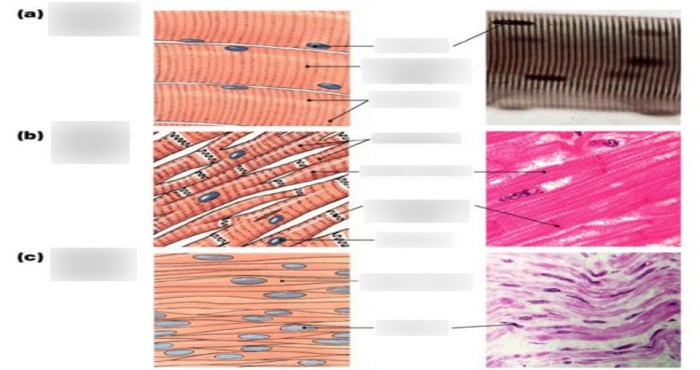Art-labeling activity structure of muscle tissues – The art-labeling activity structure for muscle tissues unveils an innovative approach to comprehending the intricacies of muscle anatomy. This engaging methodology fosters a deeper understanding of muscle tissue types, their characteristics, and their histological representation.
By integrating artistic expression with scientific inquiry, this activity transforms muscle tissue learning into an immersive and memorable experience.
Labeling Muscle Tissues

Labeling muscle tissues is a crucial technique in histology, allowing researchers and students to identify and study the different types of muscle tissues based on their specific characteristics and functions.
Muscle tissues can be broadly classified into three main types: skeletal muscle, smooth muscle, and cardiac muscle. Each type has distinct structural and functional properties that are reflected in their histological appearance.
Skeletal muscle, also known as striated muscle, is characterized by its поперечно-полосатый (banded) appearance due to the arrangement of actin and myosin filaments. Smooth muscle, on the other hand, is non-striated and has a spindle-shaped appearance with a single nucleus.
Cardiac muscle, found exclusively in the heart, is striated but has unique features such as intercalated discs, which are specialized junctions between adjacent muscle cells that allow for coordinated contractions.
Labeling muscle tissues involves using specific stains and techniques to highlight and differentiate these different types of muscle tissues. For example, hematoxylin and eosin (H&E) staining is commonly used to visualize the overall structure of muscle tissues, while immunohistochemistry can be employed to identify specific proteins or markers associated with different muscle types.
By labeling muscle tissues, researchers can gain insights into their structural organization, functional properties, and potential pathological changes. This information is essential for understanding the normal physiology and pathophysiology of various muscle-related disorders.
Art-Labeling Activity Structure

An art-labeling activity for muscle tissues is a structured educational tool that combines artistic expression with scientific learning. It involves students creating visual representations of muscle tissues, typically in the form of drawings or diagrams, and labeling the different structural components.
The art-labeling activity structure typically includes the following steps:
- Introduction:The instructor introduces the topic of muscle tissues, explaining their different types and characteristics.
- Art Creation:Students are provided with materials and guidance to create their own representations of muscle tissues. They may use pencils, markers, crayons, or other art supplies to draw or diagram the different muscle types.
- Labeling:Students then label the different structural components of their muscle tissue representations, using appropriate terminology and anatomical references.
- Discussion and Presentation:Students present their labeled art-labeling activity to the class, explaining their drawings and discussing the different muscle tissue types and their characteristics.
Procedure for Art-Labeling Activity
The procedure for an art-labeling activity for muscle tissues typically involves the following steps:
- Prepare materials:Gather necessary materials such as paper, pencils, markers, crayons, and any other art supplies needed.
- Introduce the topic:Begin by introducing the topic of muscle tissues, discussing their different types and characteristics.
- Provide examples:Show students examples of labeled muscle tissue drawings or diagrams to provide guidance and inspiration.
- Instruct students:Guide students through the art-labeling activity process, explaining the steps involved in creating and labeling their muscle tissue representations.
- Monitor progress:As students work on their art-labeling activity, provide support and guidance as needed.
- Facilitate discussion:Once students have completed their art-labeling activity, facilitate a class discussion where they present their labeled drawings and discuss the different muscle tissue types and their characteristics.
Assessment of Art-Labeling Activity

The assessment of an art-labeling activity for muscle tissues can be based on the following criteria:
- Accuracy of Labeling:Assess the accuracy and completeness of the labels applied to the muscle tissue representations.
- Artistic Representation:Evaluate the overall artistic quality and clarity of the muscle tissue drawings or diagrams.
- Presentation and Explanation:Consider the student’s ability to present their art-labeling activity and explain the different muscle tissue types and their characteristics.
- Understanding of Muscle Tissues:Assess the student’s understanding of the different types of muscle tissues and their structural and functional properties.
Query Resolution: Art-labeling Activity Structure Of Muscle Tissues
What are the benefits of using an art-labeling activity for teaching muscle tissues?
Art-labeling activities promote active learning, improve visual memory, and enhance student engagement.
How can I assess the art-labeling activity for muscle tissues?
Assessment criteria may include accuracy of labeling, understanding of muscle tissue characteristics, and creativity in the artistic representation.